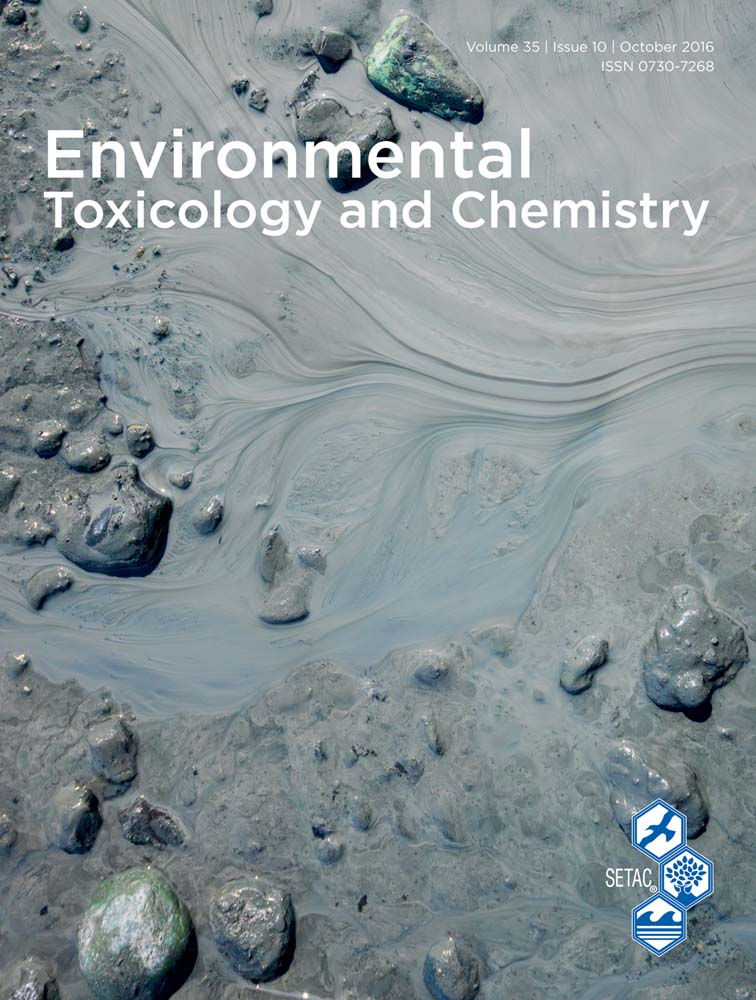Influence of bromide on the performance of the amphipod Hyalella azteca in reconstituted waters
Abstract
Poor performance of the amphipod Hyalella azteca has been observed in exposures using reconstituted waters. Previous studies have reported success in H. azteca water-only exposures with the addition of relatively high concentrations of bromide. The present study evaluated the influence of lower environmentally representative concentrations of bromide on the response of H. azteca in 42-d water-only exposures. Improved performance of H. azteca was observed in reconstituted waters with >0.02 mg Br/L. Environ Toxicol Chem 2016;35:2425–2429. Published 2016 Wiley Periodicals Inc. on behalf of SETAC. This article is a US Government work and, as such, is in the public domain in the United States of America.
INTRODUCTION
Survival, growth, and reproduction of the amphipod Hyalella azteca are frequently poor when various types of reconstituted waters (e.g., ASTM International 1) have been used to conduct >14-d water-only or sediment toxicity tests (e.g., ASTM International 2, Kemble et al. 3, and McNulty et al. 4). For example, Kemble et al. 5 compared US Environmental Protection Agency (USEPA) moderately hard reconstituted water (MHRW) and well water used in overlying water with formulated and reference sediments and observed only 3% to 53% survival of test organisms after 28 d in MHRW treatments but 95% to 100% survival in a natural well water. Recognizing the poor performance of H. azteca in MHRW, Smith et al. 6 altered the Ca to Mg ratio and added chloride to MHRW in the development of a reformulated MHRW to more closely emulate natural waters. Borgmann 7 reported success (i.e., improved survival and growth) when testing H. azteca in reconstituted water with the addition of bromide at a concentration of 0.8 mg Br/L; however, this bromide concentration is substantially above environmentally relevant concentrations in freshwater (typically ranging 0.014–0.20 mg Br/L; 8).
The USEPA held a workshop in March 2010 in Chicago, Illinois, USA, with participants from laboratories experienced in culture or testing of H. azteca in water or in sediment (over 40 individuals attended the 2-d workshop; C. Ingersoll, unpublished data). The goal of the workshop was to discuss the state of the science regarding the use of H. azteca in whole-sediment or water-only toxicity tests. Participants at the workshop reported frequent good performance of H. azteca cultured or tested in Borgmann 7 reconstituted water with the higher bromide concentration detailed above. In contrast, limited success was reported for laboratories conducting long-term (>10-d) water-only exposures of H. azteca in Smith et al. 6 reconstituted water (with no addition of bromide). The suggestion was made at the workshop that the success of a limited number of laboratories in culturing or testing H. azteca in Smith et al. 6 water may have been the result of unintentionally providing trace nutrients (e.g., bromide) through the diet or substrate or through bromide contamination in lower-quality salts used to make reconstituted water. The ionic composition of Borgmann 7 reconstituted water and of Smith et al. 6 reconstituted water is similar, other than the lack of supplemental bromide in the Smith et al. 6 reconstituted water.
A recent study showed that for at least 1 genetic strain of H. azteca there is a lower limit of chloride concentration in water that provides for optimal growth and reproduction 9; however, higher resolution on bromide requirements in H. azteca is lacking. Our objective in the present study was to follow the recommendation from the USEPA 2010 workshop to conduct studies to evaluate the influence of a range of bromide concentrations added to either Borgmann 7 reconstituted water or to Smith et al. 6 reconstituted water on the performance of H. azteca under water-only conditions. Iodide was also evaluated based on the suggestion that because little is known about the physiological function of bromide, improved performance of H. azteca may result from bromide serving as a replacement for low iodide (known to have hormonal function) in reconstituted waters. McCall et al. 10 provide evidence that bromide is an essential trace element in the development of Drosophila (fruit fly) and may be an essential trace element for all animals.
MATERIALS AND METHODS
A series of experiments were conducted to evaluate the performance of H. azteca under water-only conditions at various concentrations of bromide (Br as NaBr) or iodide (I as NaI) in reconstituted waters. These water-only exposures were conducted in accordance with methods for testing sediment toxicity outlined in ASTM International 2 and USEPA 11 (Supplemental Data, Table S1).
The base waters used for testing included 1) 300 well water (hardness of ∼300 mg/L as CaCO3); 2) 100 well water (well water diluted with deionized water to a hardness of ∼100 mg/L CaCO3); 3) Borgmann 7 reconstituted water (Borgmann reconstituted water, hardness of ∼125 mg/L CaCO3); 4) Smith et al. 6 reconstituted water (Smith reconstituted water, hardness of ∼100 mg/L CaCO3). Supplemental Data, Table S2, provides the recipes for preparing these reconstituted waters and Supplemental Data, Table S3, provides measured water quality characteristics and major ions for these reconstituted waters and for well water.
Hyalella azteca (amphipods; determined to be the US Lab strain by Major et al. 12) were obtained from cultures maintained at the US Geological Survey, in Columbia, Missouri. The exposures were conducted under flow-through conditions with approximately 2 volume additions/d of water to each test chamber 13. Each exposure chamber received 5 mL of a fine-grained Unimin Industrial Quartz Sand (e.g., <0.5 mm particles) as a substrate for the organisms because H. azteca naturally burrow in the first few millimeters of sediment 2, 11. A series of bromide (granular reagent grade NaBr; Thomas Scientific) concentrations or iodide (granular reagent grade NaI; Fisher Scientific) concentrations were delivered with each cycle of the water delivery system from stock solutions using syringe pumps (Hamilton). The age of the amphipods at the start of the exposures was 7 d. A total of 10 amphipods were exposed in each beaker. Amphipods were acclimated to test water with the addition of bromide or iodide for a minimum of 2 d before the start of the exposures. Wide-spectrum fluorescent lights with approximately 200 lux (at the water–air interface) and a 16:8-h light:dark photoperiod were provided. Amphipods were fed a ramped (food increased over time) amount of food as a diet of yeast–cerophyll–trout chow (YCT; 1.8 g/L; Supplemental Data, Table S1; 1.0 mL/d for week 1, 1.5 mL/d for week 2, 2.0 mL/d for week 3, 3.0 mL/d for week 4, 3.5 mL/d for week 5, and 4.0 mL/d for week 6). A ramped diet of YCT was provided because the standard diet recommended by the USEPA 11 of 1 mL YCT/d limited growth (dry wt) and reproduction of H. azteca in exposures conducted for longer than 10 d 14. Subsequent studies have found a diet of ramped diatoms and ramped Tetramin or a diet of YCT and ramped Tetramin to be improved compared with a ramped diet of only YCT 14-16. Surviving amphipods were removed weekly from the test chambers to check survival, and the chambers were rinsed with test water and received new sand substrate before amphipods were reintroduced. The sand substrate was held for 24 h in test water for acclimation before use in the test chambers.
A total of 8 replicates/treatment were tested with the following endpoints measured: 1) 7-d, 14-d, 21-d, 28-d survival (nondestructive samplings); 2) 28-d length (destructive sampling of 4 replicate test chambers/treatment); 3) 35-d survival and reproduction (nondestructive sampling); and 4) 42-d survival, length, and reproduction (destructive sampling of the remaining 4 replicate test chambers/treatment). Surviving amphipods on a sampling date were preserved in 8% sugar formalin for subsequent length measurement. The dry weight of each surviving amphipod from each replicate was calculated from the empirical relationship: weight (mg) = [(0.177 × length [mm]) – 0.0292]3 3, 17.
Routine water quality characteristics (dissolved oxygen, hardness, alkalinity, pH, and ammonia) were measured at least weekly during exposures, and temperature was measured daily. Bromide and iodide were initially analyzed by ion chromatography with a detection limit of approximately 0.05 mg/L for each. Concentrations of total bromine (assumed to be wholly present as bromide ion) were determined using inductively coupled plasma mass spectrometry (ICP-MS) with a detection limit of approximately 0.001 mg/L.
A first set of exposures was conducted in the spring of 2011 with the objective of determining if bromide or iodide improved the performance of H. azteca in water exposures. Bromide was tested at 3 concentrations (no Br added, 0.08 mg/L added, or 0.8 mg/L added) in Borgmann reconstituted water, Smith reconstituted water, and 100 well water. A 300 well water treatment with no added bromide or iodide was also tested. Iodide was tested at 3 concentrations (no I added, 0.005 μg L added, and 0.05 μg L added) in Borgmann and Smith reconstituted waters.
A second set of exposures was conducted in the summer of 2011 with the objective of determining if lower and more environmentally relevant concentrations of bromide (e.g., 0.014–0.20 mg Br/L) 8 might improve performance of H. azteca in chronic water exposures in various reconstituted waters. It was determined in the first round of exposures that the addition of bromide had a stronger influence on the performance of H. azteca compared to addition of iodide; therefore, iodide addition was not evaluated in the summer 2011 exposures. Bromide was tested at 6 concentrations (0 mg Br/L, 0.02 mg Br/L, 0.04 mg Br/L, 0.08 mg Br/L, 0.16 mg Br/L, and 0.32 mg Br/L) in Borgmann and Smith reconstituted waters and in 100 well water and 300 well water with no added bromide. A third 300 well water treatment was run in the fall of 2011 with no addition of bromide.
RESULTS AND DISCUSSION
Water quality parameters such as hardness, pH, alkalinity, and conductivity were consistent relative to the base waters (i.e., Borgmann, Smith, 100 well, 300 well; Supplemental Data, Table S3) across the bromide or iodide exposure concentrations and across the 2 studies. Borgmann, Smith, 100 well, and 300 well water exposures had hardness (as CaCO3) ranges of 110 mg/L to 140 mg/L (in Borgmann water), 96 mg/L to 117 mg/L (in Smith water), 104 mg/L to 110 mg/L (in 100 well water), and 286 mg/L to 310 mg/L (in 300 well water). Average dissolved oxygen was >6.0 mg/L, and total ammonia was <0.8 mg N/L across all exposures for all tests. It was determined from the first set of exposures that dissolved oxygen was reduced (e.g., as low as 3.8 mg/L) with addition of 3.5 mL YCT/d at week 5 of the exposure; therefore, YCT was not ramped above 3 mL/d in subsequent exposures (Supplemental Data, Table S1). All measured bromide and iodide concentrations were within 20% of nominal when determined by ICP-MS or ion chromatography (where detectable; Supplemental Data, Tables S4 and S5).
Performance of H. azteca was evaluated relative to proposed test acceptability criteria for revisions being considered to ASTM International 2 and USEPA 11 for conducting 42-d water or sediment exposures with H. azteca tested with 2 new diet rations and with water quality requirements of >15 mg Cl/L and >0.020 mg Br/L 15. Specifically, the test acceptability criteria were established as 10-d, 28-d, and 42-d survival >80%; 10-d dry weight >0.050 mg/individual; 28-d dry weight >0.35 mg/individual; 42-d dry weight >0.50 mg/individual; and 42-d young/surviving female >6.0 (Supplemental Data, Table S1).
In the spring 2011 and summer 2011 studies, the test acceptability criteria were typically exceeded in the exposures conducted in 300 well water and 100 well water without the addition of bromide or iodide. The addition of bromide did not improve performance of amphipods in 100 well water (a water that naturally contains bromide at a level of ∼0.03 mg Br/L; Supplemental Data, Tables S4 and S5). Addition of bromide to Borgmann water and to Smith water resulted in meeting test acceptability criteria from increased 42-d survival (Figure 1), increased 42-d weight (Figure 2), and increased 42-d young/female (Figure 3). Reproduction increased with increased weight, except in Borgmann water or in Smith water without the addition of bromide (Figure 4). In all exposures where bromide was >0.020 mg/L, the test acceptability criteria were exceeded except in 2 cases: 1) 28-d weight of 0.267 mg/individual in 100 well water (Supplemental Data, Table S4) and 2) survival of 78% in 300 well water (Supplemental Data, Table S5). Conversely, in 3 of the 4 waters to which no bromide was added survival and reproduction did not meet test acceptability criteria, and for 2 of the 4 waters weight did not meet test acceptability criteria (Figures 1–3).
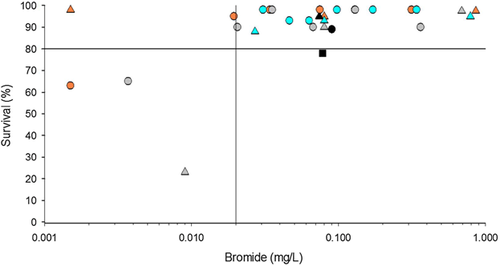
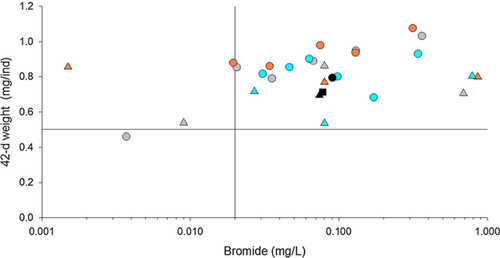
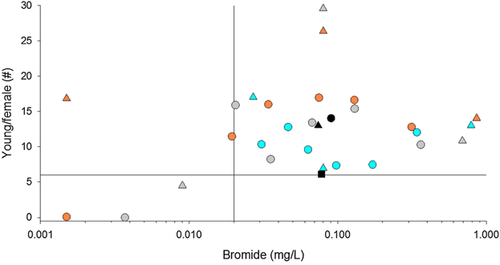
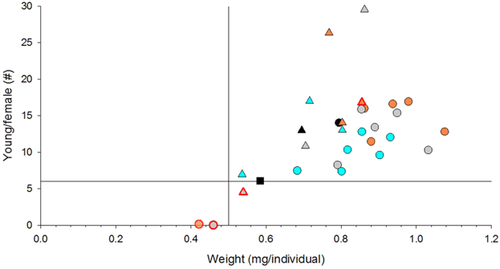
Growth and reproduction of amphipods slightly improved with the addition of iodide in Borgmann water but not Smith water (Supplemental Data, Table S4). Survival in the 2 iodide concentrations (0.005 mg I/L and 0.05 mg I/L) in Smith water was 93%; however, survival in Borgmann water was below the test acceptability criterion of 80% (75% in 0.005 mg I/L and 73% in 0.05 mg I/L; Supplemental Data, Table S4). For these reasons, iodide addition was not further evaluated in the summer 2011 exposures.
Survival, growth, and reproduction of amphipods improved with the addition of bromide, even at the lowest concentration of 0.020 mg Br/L (Figures 1–3), which is a more environmentally relevant concentration of bromide than the 0.8 mg Br/L recommended in Borgmann 7. Concentrations of bromide in freshwater reportedly range from 0.014 mg Br/L to 0.20 mg Br/L 8. Moreover, bromide concentrations as high as 20 mg/L had no effect on survival, growth, or reproduction of H. azteca in 42-d water-only exposures compared to lower concentrations of bromide (data not shown).
Good performance (i.e., meeting survival, weight, and reproduction test acceptability criteria) of amphipods was observed in the first Smith reconstituted water experiment without the addition of bromide (e.g., Figures 1–3; Supplemental Data, Table S4), which may have been because the starting size (∼0.03 mg/individual) in this set of exposures was larger than H. azteca used in routine testing by US Geological Survey-Columbia (e.g., <0.006 mg/individual). As Supplemental Data, Figure S3, shows, larger amphipods at day 28 produce more young. Good performance could have also been the result of a trace amount of bromide being present in the control water.
In previous studies that evaluated approaches to improve the performance of H. azteca, the addition of bromide or Instant Ocean salts to ASTM International hard water (∼170 mg/L hardness 1) improved 42-d survival but did not improve growth or reproduction of H. azteca relative to 300 well water or Borgmann reconstituted water (C. Ivey, unpublished data). After adding the salts used in preparing ASTM International hard water, the water contains approximately 163 mg sulfate/L and only approximately 4 mg Cl/L. This concentration of sulfate is above concentrations that occur in natural waters (D. Mount, USEPA, Duluth, MN, unpublished data). In studies conducted by Soucek et al. 9, growth or reproduction of H. azteca in 10-d to 42-d studies declined below 15 mg Cl/L to 20 mg Cl/L.
In summary, the addition of bromide improved 42-d survival, growth, and reproduction of a US Lab strain of H. azteca in Borgmann reconstituted water and in Smith reconstituted water at more environmentally relevant levels than the 0.8 mg Br/L recommended in Borgmann 7. The results of the present study indicate that as long as a minimal concentration of bromide is present, either background or supplemental, additional bromide (up to 20 mg/L) does not result in further improved performance or toxicity. Based on the results of the present study and the results of other studies, it is recommended that all H. azteca exposure waters or culture waters have >15 mg Cl/L 9, 14 and >0.02 mg Br/L 15.
Supplemental Data
The Supplemental Data are available on the Wiley Online Library at DOI: 10.1002/etc.3421.
Acknowledgment
We thank D. Mount and R. Hockett of USEPA-Duluth, D. Soucek of the Illinois Natural History Survey, and B. Brumbaugh of US Geological Survey-Columbia for guidance on experimental design and interpretation of results. We also thank the members of US Geological Survey-Columbia Toxicology Branch and Chemistry Branch for technical support.
Disclaimer
Any use of trade, product, or firm names is for descriptive purposes only and does not imply endorsement by the US government. Funding for the present study was provided in part by USEPA Region 5. The USEPA has not formally reviewed this publication, and the views expressed herein may not reflect the views of the USEPA.
Data availability
Data, associated metadata, and calculation tools are available on request ([email protected]).



